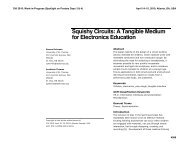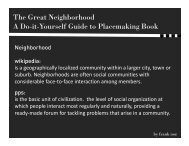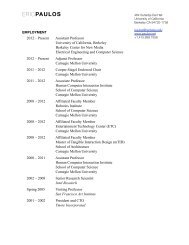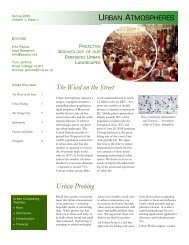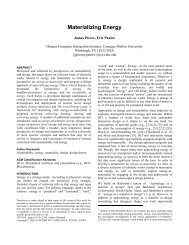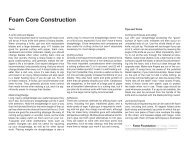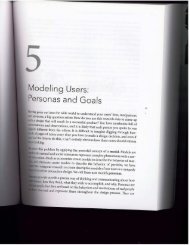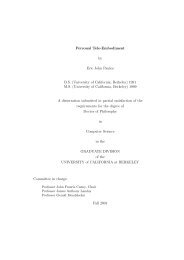The Foundations of Design: Scenarios and Requirements
The Foundations of Design: Scenarios and Requirements
The Foundations of Design: Scenarios and Requirements
- No tags were found...
You also want an ePaper? Increase the reach of your titles
YUMPU automatically turns print PDFs into web optimized ePapers that Google loves.
112 Part I: Underst<strong>and</strong>ing Goal-Directed <strong>Design</strong>-<strong>The</strong> missing ingredient in Carroll's scenario-based design methods is the use <strong>of</strong>personas. A persona provides a tangible representation <strong>of</strong>the user to act as a believ.able agent in the setting <strong>of</strong> a scenario. In addition to reflecting current behaviorpatterns <strong>and</strong> motivations, personas enable the exploration <strong>of</strong>how user motivationsshould inflect <strong>and</strong> prioritize tasks in the future. Because personas model goals <strong>and</strong>not simply tasks, the scope <strong>of</strong> the problems addressed by scenarios can be broadenedto include those related to product definition. <strong>The</strong>y help answer the questions,"What should this product do?" <strong>and</strong> "How should this product look <strong>and</strong> behavd"Using personas in scenariosPersona-basedscenarios are concise narrative descriptions<strong>of</strong>oneor more personasusing a product to achieve specific goals. <strong>The</strong>y allow us to start our designs from astory describing an ideal experience from the persona's perspective, focusing onpeople, <strong>and</strong> how they think <strong>and</strong> behave, rather than on technology or business goals.<strong>Scenarios</strong> can capture the nonverbal dialogue 4 between the user <strong>and</strong> a product, environment,or system over time, as well as the structure <strong>and</strong> behavior <strong>of</strong> interactivefunctions. Goals serve as a filter for tasks <strong>and</strong> as guides for structuring the display <strong>of</strong>information <strong>and</strong> controls during the iterative process <strong>of</strong>constructing the scenarios.Scenario content <strong>and</strong> context are derived from infonnation gathered during theResearch phase <strong>and</strong> analyzed during the Modeling phase. <strong>Design</strong>ers role-play personasas the characters in these scenarios,S similar to actors performing improvisation.This process leads to real·time synthesis <strong>of</strong> structure <strong>and</strong> behaviortypically,at a whiteboard - <strong>and</strong> later informs the detailed look-<strong>and</strong>·feel. Finall)",personas <strong>and</strong> scenarios are used to test the validity <strong>of</strong>design ideas <strong>and</strong> assumptionsthroughout the process.Different types <strong>of</strong> scenarios<strong>The</strong> Goal-Directed <strong>Design</strong> method employs three types <strong>of</strong>persona-based scenamat different points in the process, each with a successively more interface-specificfocus. <strong>The</strong> first - the context scenario - is used to explore, at a high level, how meproduct can best serve the needs <strong>of</strong>the personas. (We used to call these "day-inlifescenarios," but found that term excessively broad.) <strong>The</strong> context scenarios artated before any design is performed <strong>and</strong> are written from the perspective <strong>of</strong>persona, focused on human activities, perceptions, <strong>and</strong> desires. It is in the de'\ment <strong>of</strong>this kind <strong>of</strong>scenario that the designer has the most leverage to imagineideal Us.fOund 1



